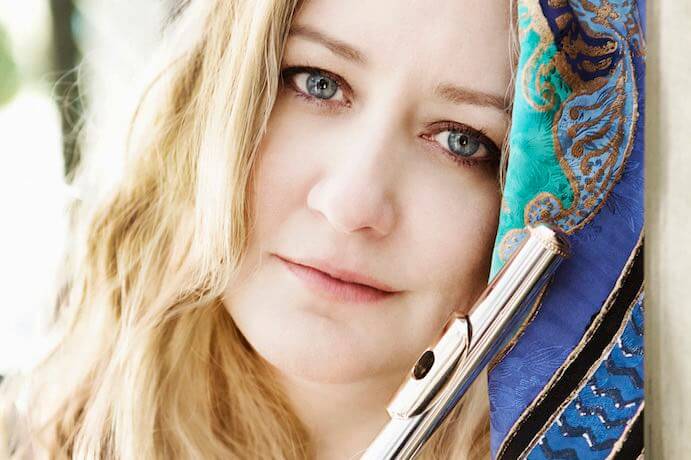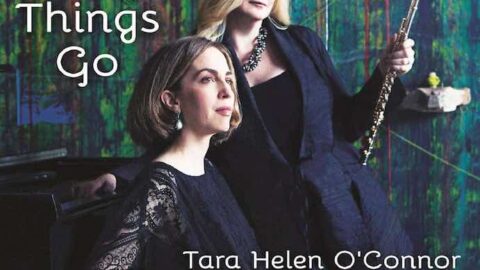Flutist Tara Helen O’Connor‘s recent Bridge Records album release, The Way Things Go, is a compilation of contemporary flute works meant to “challenge ears and minds that have been conditioned to a set of historical precedents.” The seven works on the album transport the listener through a tangle of textures, timbres, and motion. Accompanied by the delicate touch of Margaret Kampmeier on piano, O’Connor fiercely wends her way through seven works, including the Richard Festinger piece for which the album is titled—all composed since 1985, with most having been composed since the turn of the century. O’Connor’s artfully curated “labor of love” offers a lively survey of contemporary flute music. Yet grandiose claims of challenging historical precedents and even “the shifting of stylistic gears” fall flat considering that compositions featured on the album were largely written by academically-trained white American composers. Differences in approach and theme bleed together across the 74 minutes into a mostly homogenous sound world that is nevertheless enjoyable and enchanting.

Festinger’s The Way Things Go (2005), which was commissioned by O’Connor, weaves quarter tones and flutter tongue into a carefully-proportioned three-movement structure. In “Variations,” “Recitative,” and “Finale,” Festinger explores patterns of repetition and deviation with incessant upturned phrases on the flute matched with luminous chords on the piano. Festinger’s compositional approach, which has been described by Karen Moorman as “economic,” is heavily focused on form, and his liner notes offer a blow-by-blow of the sonorities and their journeys and juxtapositions. One wonders if this is meant as twenty-first-century absolute music, or if the sounds exist in this sequence solely for sheer “performativity,” or what Festinger refers to as “a virtuosic partnership between the flute and piano.” Despite the formal complexity, The Way Things Go pops along brightly through its lilting phrases. The final movement arpeggiations whiz and whorl like objects tossed into the air that then spiral back down.
The strongest offering on the recording is Laura Kaminsky‘s Duo for Flute and Piano (2006), also in three movements, and also written for and dedicated to O’Connor and Kampmeier. Whereas Festinger’s piece is propulsed by proportionality and virtuosity, Kaminsky’s themes flow in an almost neo-Romantic trajectory. The outer movements are lively in a sort of blithe, peppy sentimentality, while the slower inner movement pairs peaceful, pensive flute lines with Satie-esque harmonies on the piano—static yet clambering, happy yet melancholy. The third meaty three-movement piece on the album, John Halle‘s Gaze (2000), dances its way through an intimidating array of mouth & tongue gymnastics, executed flawlessly by O’Connor. A rangey first movement flits between extreme registers, pelting down a stream of very low and very high notes, before the second movement tango and third movement rag. Despite its fun, even tongue-in-cheek tone, Halle describes the third movement as “absurdly difficult.” The rapidly fluctuating tempi present no problem for O’Connor, whose gleeful interpretation does not betray the demanding nature of the piece.
Other highlights include Steven Mackey‘s Crystal Shadows (1985), a curious assemblage of sounds which are blown and across into the flute, struck staccato-style on the piano, and plucked on piano strings. Mackey states that the themes here include “delineating topographies” and “fringe states of consciousness.” The sound world he constructs from these interests is unique and wide-ranging, the sort of work in which one can get lost again and again. Belinda Reynolds‘s Share (2003), for alto flute and piano, allows for a thoughtful, quiet juncture amid all the showy acrobatics. Her sparse musical language is lovely, a striking reminder that, sometimes, less is more. Randall Woolf‘s Righteous Babe (2003), is a flashy introduction to the album, with motoric repetitions and catchy phrases. These jaunty tunes seem to invite the listener along for O’Connor’s ride, a labor of love to be sure, and one that for the most part mingles dexterity and craft with a sprightly, sparkling joy.
























